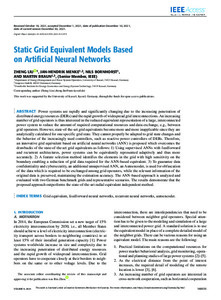| dc.date.accessioned | 2022-04-29T12:03:00Z | |
| dc.date.available | 2022-04-29T12:03:00Z | |
| dc.date.issued | 2021-12-30 | |
| dc.identifier | doi:10.17170/kobra-202204296110 | |
| dc.identifier.uri | http://hdl.handle.net/123456789/13796 | |
| dc.description.sponsorship | Gefördert durch den Publikationsfonds der Universität Kassel | |
| dc.language.iso | eng | |
| dc.rights | Namensnennung 4.0 International | * |
| dc.rights.uri | http://creativecommons.org/licenses/by/4.0/ | * |
| dc.subject | Grid equivalent | eng |
| dc.subject | feedforward neural networks | eng |
| dc.subject | recurrent neural networks | eng |
| dc.subject | autoencoder | eng |
| dc.subject.ddc | 333 | |
| dc.title | Static Grid Equivalent Models Based on Artificial Neural Networks | eng |
| dc.type | Aufsatz | |
| dcterms.abstract | Power systems are rapidly and significantly changing due to the increasing penetration of distributed energy resources (DERs) and the rapid growth of widespread grid interconnections. An increasing number of grid operators is thus interested in the reduced equivalent representation of a large, interconnected power system to reduce the amount of required computational resources and data exchange, e.g., between grid operators. However, state-of-the-art grid equivalents become more and more inapplicable since they are analytically calculated for one specific grid state. They cannot properly be adapted to grid state changes and the behavior of the increasingly used controllers, such as reactive power controllers of DERs. Therefore, an innovative grid equivalent based on artificial neural networks (ANN) is proposed which overcomes the drawbacks of the state-of-the-art grid equivalents as follows: 1) Using supervised ANNs with feedforward and recurrent architectures, power systems can be equivalently represented adaptively and thus more accurately. 2) A feature selection method identifies the elements in the grid with high sensitivity on the boundary enabling a reduction of grid data required for the ANN-based equivalent. 3) To guarantee data confidentiality and cybersecurity, an additional unsupervised ANN, an Autoencoder, is used for obfuscation of the data which is required to be exchanged among grid operators, while the relevant information of the original data is preserved, maintaining the estimation accuracy. The ANN-based approach is analyzed and evaluated with two German benchmark grids and representative scenarios. The results demonstrate that the proposed approach outperforms the state-of-the-art radial equivalent independent method. | |
| dcterms.accessRights | open access | |
| dcterms.creator | Liu, Zheng | |
| dcterms.creator | Menke, Jan-Hendrik | |
| dcterms.creator | Bornhorst, Nils | |
| dcterms.creator | Braun, Martin | |
| dc.relation.doi | doi:10.1109/ACCESS.2021.3134373 | |
| dc.subject.swd | Neuronales Netz | ger |
| dc.subject.swd | Feedforward-Netz | ger |
| dc.subject.swd | Elektrizitätsversorgungsnetz | ger |
| dc.subject.swd | Stromversorgung | ger |
| dc.type.version | publishedVersion | |
| dcterms.source.identifier | eissn:2169-3536 | |
| dcterms.source.journal | IEEE Access | eng |
| dcterms.source.pageinfo | 168535-168546 | |
| dcterms.source.volume | Volume 9 | |
| kup.iskup | false | |


